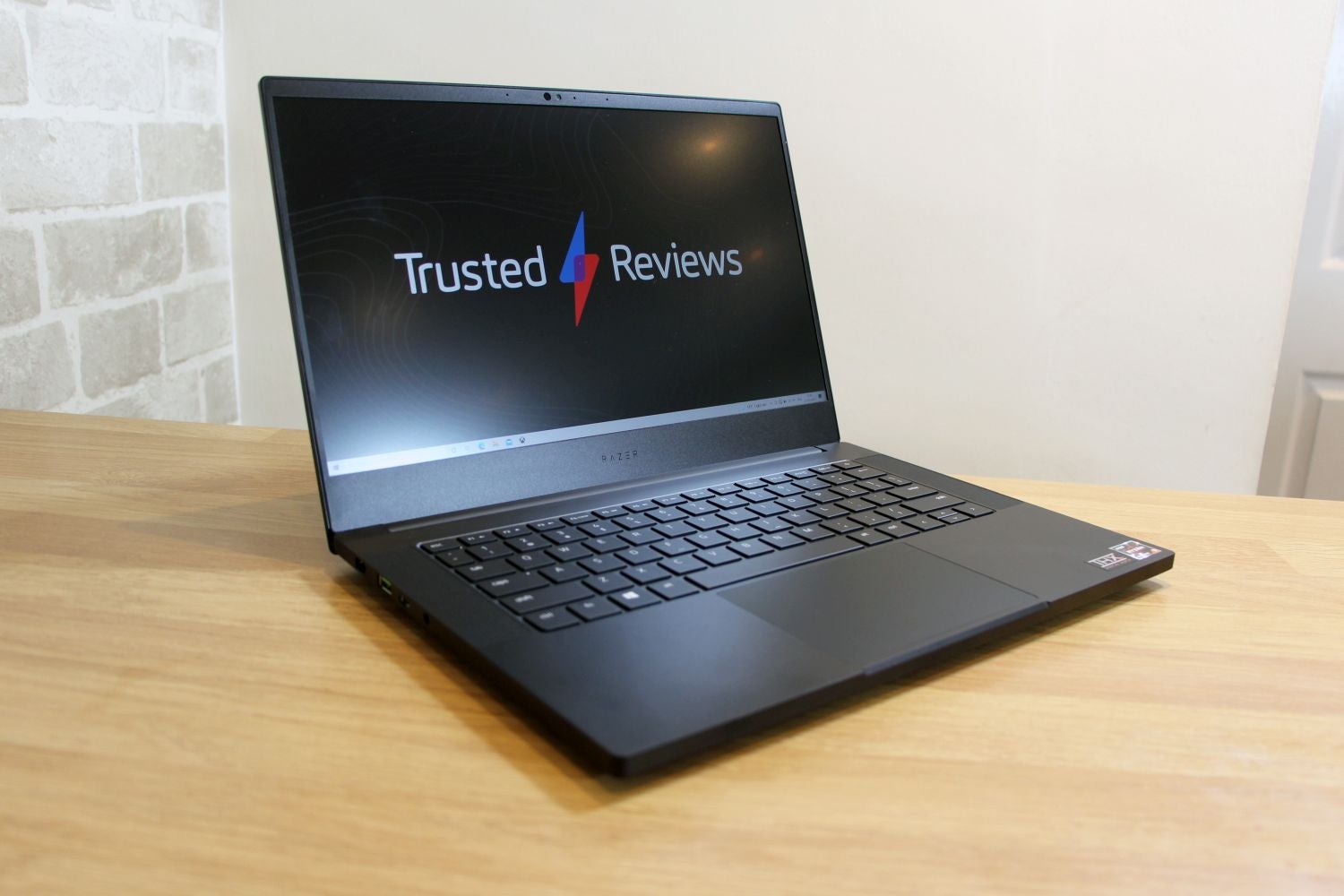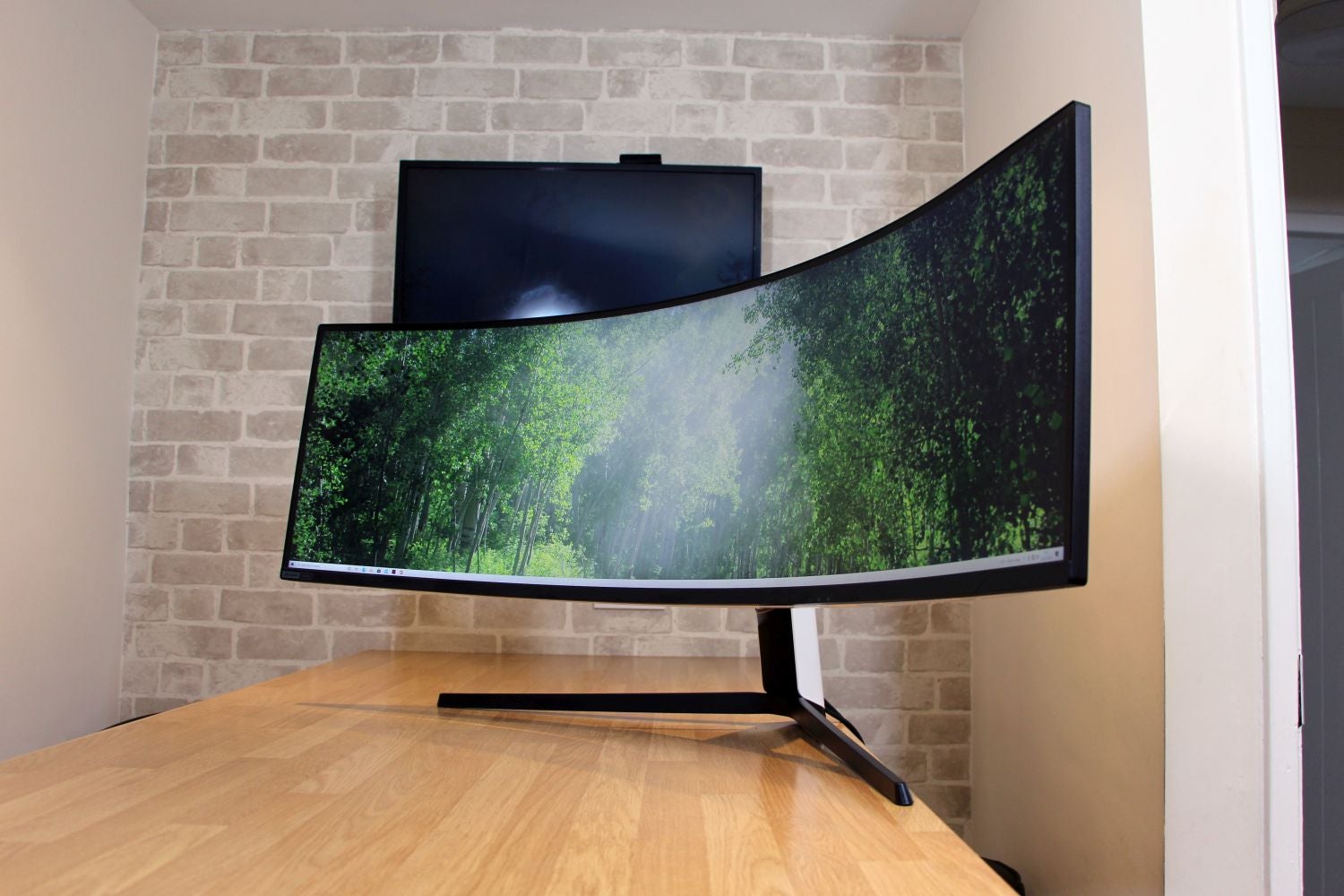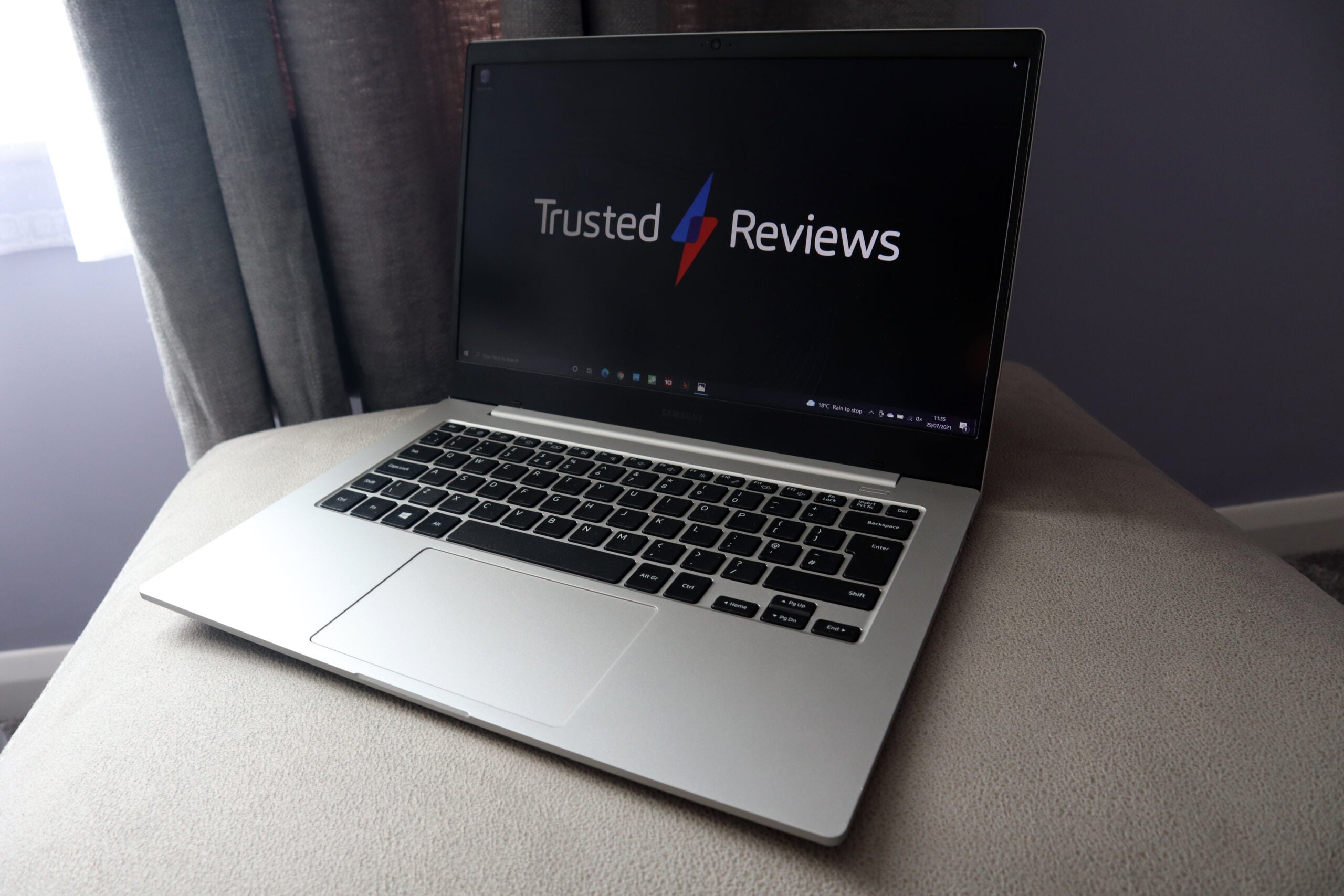Verdict
The Blade 14 is the latest flagship gaming notebook from Razer. It aims to offer gamers powerhouse performance, in a form factor that’s thin and light enough to fit to be used on the go. The Razer Blade 14 proves itself to be eminently portable, and it includes top hardware. Highlights include lashings of gaming and productivity power alongside a great screen and solid keyboard.
Pros
- Slim, smart and robust 14in design
- Powerful RTX 3070 graphics core
- Superb AMD processor
- High-quality 1440p display
Cons
- Exterior sometimes gets hot
- Expensive considering the components
- No numberpad
Availability
- UKRRP: £2199
- USARRP: $2199
- EuropeRRP: €2399
Key Features
-
Slim, light designThe latest Blade has a 14in screen inside a slim, light body – so it’s portable and powerful -
Nvidia RTX 3070 GPUThe RTX 3070 delivers lashings of power – perfect for mainstream games and esports titles on the 1440p, 165Hz screen -
Top-notch AMD processorThis is the first time a Blade has had an AMD processor, and the Ryzen 9 5900HX is a tremendous option for work and play.
Introduction
Razer builds some of the best gaming laptops in the world, but recently it has gotten a little too comfortable with conventional form factors – so I’m delighted to see the Razer Blade 14 arrive.
It’s a new size for Razer, and it takes aim at the sweet spot between tiny 13-inch machines and larger, more conventional 15.6-inch notebooks. It’s a tempting middle ground that promises plenty of gaming power inside a more portable design, and it hopes to become one of our best laptop choices.
The model I’ve reviewed deploys Nvidia GeForce RTX 3070 graphics alongside an AMD Ryzen 9 5900HX CPU – which means this is the first AMD-based Razer laptop. It’s not cheap though, at £2,199 / $2,199 / €2,399. If you’re on a tight budget, there’s a version with the RTX 3060 for £1,799 / $1,799 / €1,999. And if you’re feeling flush, the RTX 3080 version costs £2,799 / $2,799 / €2,999.
The Blade isn’t the only big-name gaming laptop available in 14-inches. Asus kickstarted this trend with the ROG Zephyrus G14, and that machine is a formidable opponent for the Blade. The G14 isn’t available with an RTX 3070, but the machine with an RTX 3060 and an AMD Ryzen 9 5900HS costs £1,799 / $1,969 / €1,899.
Design and keyboard
- It’s small, slim, light and sturdy – classic Razer design throughout
- Connectivity is good, but the Blade misses out on Ethernet and Thunderbolt inputs
- The keyboard is crisp and quick, but there’s not a huge amount of travel
The Blade may be a new size for Razer, but the design is reassuringly familiar. This machine is built from CNC-milled aluminium and it is classic Razer: all black metal, clean lines and no bloat.
Razer’s machine pairs its good-looking design with reassuring build quality. There’s hardly any movement in the base and only a little flex in the display. It’s the kind of laptop that you can toss into a bag without concern, although you may want a sleeve to avoid scuffs and scratches based on my experience testing it.

This Blade weighs 1.78kg and it’s 16.8mm thick, so it’s a slim, light machine. The only downside here is the power brick: it’s physically large and weighs 660g. Also bear in mind that the Asus is better here. Its charger weighs 1.6kg and is only a little thicker.
Each side of the Blade houses a USB 3.2 Gen 2 port and a USB-C port that supports power delivery and DisplayPort output. The Blade also has an HDMI output. On the inside, connectivity is handled by dual-band WiFi 6 and Bluetooth 5.2, and above the screen there’s a webcam that supports Windows Hello. It’s good connectivity, but it’s not perfect: the reliance on AMD means there’s no Thunderbolt, there’s no fingerprint reader, and no Ethernet.

The keyboard is typical Razer fare, and that’s no bad thing. The buttons are crisp, with ample consistency and comfort, and the per-key RGB LED lighting is bright, sharp and customisable. The keyboard has n-key rollover, too. For gaming on the move it’s very good, and you’ll certainly be able to play mainstream games using the rapid, satisfying Razer keys.
There are inevitable compromises, though. There’s no number pad, and the cursor keys and a few of the secondary buttons are small. The Asus was a little better here, with marginally bigger buttons, a little more travel and extra buttons for handling audio.
The trackpad is good, too – responsive and fast, and a little bigger than the G14’s unit. But if you want to enjoy any kind of gaming you’ll always attach a USB mouse.
Screen
- The 1440p resolution and 165Hz refresh rate means crisp, smooth gaming
- Quality levels are impressive, with good contrast and colours
- The speakers are reasonable and usable, but a headset is better
The Blade I’ve reviewed has a 2560 x 1440 IPS display with a refresh rate of 165Hz. That’s a good specification for high-quality mainstream gaming. The high resolution and small screen mean games are crisp, and the refresh rate is high enough to make top single-player games and mainstream esports titles run smoothly. It doesn’t have syncing, but its absence is not notable.
You’ll only want to seek out a laptop with a 240Hz or 360Hz refresh rate if you’re committed to playing esports titles at a high level.

The Blade’s display has good quality, too. The brightness level of 343 nits is good enough for indoor and outdoor use, and the contrast level of 1072:1 is solid – it delivers ample depth and vibrancy. The panel rendered 99.6% of the sRGB gamut at 142% volume, which means colours have incredible punch, and the Delta E of 3.02 is fine – not brilliant, but good enough to keep things accurate. This means games look bright, crisp and nuanced on this panel. It’s better than the Asus, too: that display is also available at 1440p, but it has lower refresh rates.
The speakers are reasonable. During testing I found they’ve got loads of punch considering the laptop’s size, and a surprising amount of bass. The top-end is decent, although the mid-range is too muddy and indistinct. I’d recommend a headset for high-quality sound, but the Blade’s speakers are capable enough for semi-casual use.
Performance
- The RTX 3070 is fast enough for any gaming situation
- AMD’s Ryzen 9 5900HX is superb: perfect for work alongside gaming
- The Blade is not loud, but it does get too hot in certain situations
This is the first Razer laptop to use an AMD processor. The Ryzen 9 5900HX deploys the fantastic Zen 3 architecture, and it has eight cores alongside base and boost speeds of 3.3GHz and 4.6GHz. In all three Blade models it’s joined by 16GB of memory and a 1TB SSD that delivered rapid read and write speeds of 3,569MB/s and 2,790MB/s during testing.
This Blade uses the Nvidia GeForce RTX 3070 8GB. Nvidia is allowing laptop firms to set their own power limits with these chips, and here the 3070 runs at 100W – 25W short of the chip’s theoretical peak. The same power limit is used in the RTX 3060 and RTX 3080 versions of the laptop, too.

Still, that’s not too restrictive. At the display’s native 1440p resolution the RTX 3070 delivered averages of 51fps and 65fps in Borderlands 3 and Horizon Zero Dawn. Those good results mean you’ll be able to play top single-player games at smooth framerates – and experiment with Ray-Tracing and DLSS. In the easier Dirt Rally the Blade averaged 97fps at 1440p and 108fps at 1080p, so you’ll also be able to play esports titles at the speeds demanded by the 165Hz display.
Unsurprisingly, the RTX 3070 is significantly quicker than the RTX 3060 inside the Asus. When running Borderlands 3 at 1440p the G14 only averaged 37fps and 51fps in Borderlands and Horizon.
The AMD chip is fantastic. In the Geekbench single- and multi-core tests it scored 1,456 and 7,408, with both results easily ahead of the Intel chips that are inside equivalent notebooks. It’s easily powerful enough to avoid gaming bottlenecks, and it’s got the grunt to tackle photo-editing, video work and design tools too – so it’s ideal for tough work.
| Raxer Blade 14 (2021) | Asus ROG Zephyrus G14 (2021) | Razer Blade 15 (2021) | |
| Processor | Ryzen 9 5900HX | Ryzen 9 5900HS | Intel Core i7-10750H |
| Geekbench 5 single-core | 1456 | 1470 | 1147 |
| Geekbench 5 multi-core | 7408 | 8236 | 5232 |
| PCMark 10 | 7017 | 6608 | 5405 |
| GPU | Nvidia RTX 3070 | Nvidia RTX 3060 | Nvidia RTX 3070 |
| 3DMark Time Spy | 8721 | 6241 | 7687 |
The Razer is a reasonable thermal performer, although it has some rough edges. In games it’s impressively quiet – the fan noise is modest and the speakers or a headset will handle the noise without issue. Run less-demanding games and it’ll make even less noise, too. It’s even quieter when the processor is pushed, which makes it an ideal option for mobile working.
There are heat issues, though. When running tough games, the metal above the keyboard is too hot to touch, and the underside is similarly toasty. If you’re using the Blade on a desk then that’s fine, but it means this machine isn’t suitable to use on your lap while gaming. Happily, the heat issues are not bad when working and they don’t arise in easier games, but it’s worth bearing in mind.
Battery Life
- No surprises here: this laptop lasts just over an hour when gaming
- The Blade is better elsewhere, with a seven-hour lifespan in office tasks
The Blade may be lightweight, but it has typical gaming laptop battery life: in a gaming test it lasted for 1 hour and 7 minutes, and that’s with reduced performance. Stay plugged in to get the most out of this machine when gaming.

The Blade is better in other scenarios. When running an office work test the Razer lasted for 7 hours 6 mins, which is around half an hour better than the Asus and easily enough to get you beyond lunch. The Blade even lasted 12 hours during a video benchmark, so you’ll see a day of use from this machine if you don’t push its hardware.
Best Offers
Should you buy it?
You’re searching for a sleek, compact and fast gaming laptop
Razer crams enormous power inside this machine – and it’s slim, light and extremely portable too. A great compact machine.
You need high-end GPU power or a laptop for esports
The RTX 3080 in larger machines will be far quicker, and keen esports gamers will want more than a 165Hz refresh rate.
Final Thoughts
The Razer Blade 14 is small, sturdy and eminently portable, and it includes lashings of gaming and productivity power alongside a great screen and solid keyboard – it’s a very impressive notebook. It gets hot sometimes, though, and bigger machines will have beefier GPUs, more connectivity and faster refresh rates.
How we test
We test every laptop we review thoroughly over an extended period of time. We use industry standard tests to compare features properly. We’ll always tell you what we find. We never, ever, accept money to review a product.
Used as our main laptop for the review period
Tested for at least a week
Used consistent benchmarks for fair comparisons with other laptops
Reviewed using respected industry benchmarks and real world use
FAQs
As usual, the Blade has a one-year warranty.
The Blade 14’s base can be removed with a Torx screwdriver. On the inside you can access the wireless chip and two M.2 SSD connectors, but the memory is soldered to the motherboard.
Trusted Reviews Test Data
PCMark 10
Geekbench 5 single core
Geekbench 5 multi core
3DMark Time Spy
CrystalDiskMark Read speed
CrystalMarkDisk Write Speed
Brightness
Black level
Contrast
White Visual Colour Temperature
sRGB
Adobe RGB
DCI-P3
PCMark Battery (office)
PCMark Battery (gaming)
Battery Life
Borderlands 3 frame rate (Quad HD)
Borderlands 3 frame rate (Full HD)
Horizon Zero Dawn frame rate (Quad HD)
Horizon Zero Dawn frame rate (Full HD)
Dirt Rally (Quad HD)
Dirt Rally (Full HD)
›
Specs
UK RRP
USA RRP
EU RRP
CPU
Manufacturer
Screen Size
Storage Capacity
Front Camera
Battery
Battery Hours
Size (Dimensions)
Weight
ASIN
Operating System
Release Date
First Reviewed Date
Model Number
Model Variants
Resolution
Refresh Rate
Ports
Audio (Power output)
GPU
RAM
Connectivity
Colours
Display Technology
Screen Technology
Touch Screen
Convertible?
›













